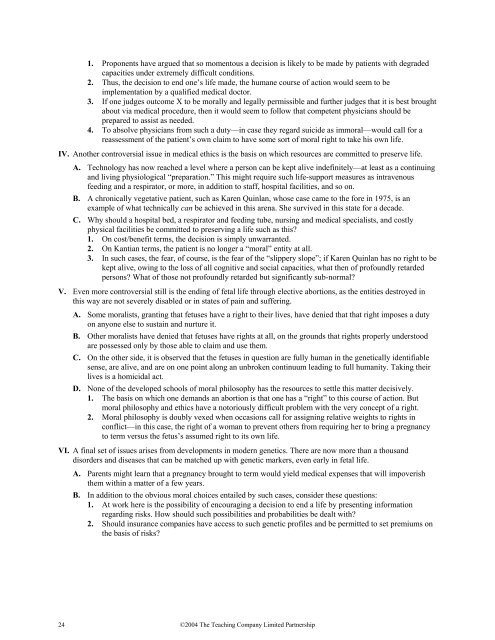Great Ideas of Philosophy
Great Ideas of Philosophy
Great Ideas of Philosophy
- No tags were found...
Create successful ePaper yourself
Turn your PDF publications into a flip-book with our unique Google optimized e-Paper software.
1. Proponents have argued that so momentous a decision is likely to be made by patients with degradedcapacities under extremely difficult conditions.2. Thus, the decision to end one’s life made, the humane course <strong>of</strong> action would seem to beimplementation by a qualified medical doctor.3. If one judges outcome X to be morally and legally permissible and further judges that it is best broughtabout via medical procedure, then it would seem to follow that competent physicians should beprepared to assist as needed.4. To absolve physicians from such a duty—in case they regard suicide as immoral—would call for areassessment <strong>of</strong> the patient’s own claim to have some sort <strong>of</strong> moral right to take his own life.IV. Another controversial issue in medical ethics is the basis on which resources are committed to preserve life.A. Technology has now reached a level where a person can be kept alive indefinitely—at least as a continuingand living physiological “preparation.” This might require such life-support measures as intravenousfeeding and a respirator, or more, in addition to staff, hospital facilities, and so on.B. A chronically vegetative patient, such as Karen Quinlan, whose case came to the fore in 1975, is anexample <strong>of</strong> what technically can be achieved in this arena. She survived in this state for a decade.C. Why should a hospital bed, a respirator and feeding tube, nursing and medical specialists, and costlyphysical facilities be committed to preserving a life such as this?1. On cost/benefit terms, the decision is simply unwarranted.2. On Kantian terms, the patient is no longer a “moral” entity at all.3. In such cases, the fear, <strong>of</strong> course, is the fear <strong>of</strong> the “slippery slope”; if Karen Quinlan has no right to bekept alive, owing to the loss <strong>of</strong> all cognitive and social capacities, what then <strong>of</strong> pr<strong>of</strong>oundly retardedpersons? What <strong>of</strong> those not pr<strong>of</strong>oundly retarded but significantly sub-normal?V. Even more controversial still is the ending <strong>of</strong> fetal life through elective abortions, as the entities destroyed inthis way are not severely disabled or in states <strong>of</strong> pain and suffering.A. Some moralists, granting that fetuses have a right to their lives, have denied that that right imposes a dutyon anyone else to sustain and nurture it.B. Other moralists have denied that fetuses have rights at all, on the grounds that rights properly understoodare possessed only by those able to claim and use them.C. On the other side, it is observed that the fetuses in question are fully human in the genetically identifiablesense, are alive, and are on one point along an unbroken continuum leading to full humanity. Taking theirlives is a homicidal act.D. None <strong>of</strong> the developed schools <strong>of</strong> moral philosophy has the resources to settle this matter decisively.1. The basis on which one demands an abortion is that one has a “right” to this course <strong>of</strong> action. Butmoral philosophy and ethics have a notoriously difficult problem with the very concept <strong>of</strong> a right.2. Moral philosophy is doubly vexed when occasions call for assigning relative weights to rights inconflict—in this case, the right <strong>of</strong> a woman to prevent others from requiring her to bring a pregnancyto term versus the fetus’s assumed right to its own life.VI. A final set <strong>of</strong> issues arises from developments in modern genetics. There are now more than a thousanddisorders and diseases that can be matched up with genetic markers, even early in fetal life.A. Parents might learn that a pregnancy brought to term would yield medical expenses that will impoverishthem within a matter <strong>of</strong> a few years.B. In addition to the obvious moral choices entailed by such cases, consider these questions:1. At work here is the possibility <strong>of</strong> encouraging a decision to end a life by presenting informationregarding risks. How should such possibilities and probabilities be dealt with?2. Should insurance companies have access to such genetic pr<strong>of</strong>iles and be permitted to set premiums onthe basis <strong>of</strong> risks?24©2004 The Teaching Company Limited Partnership














